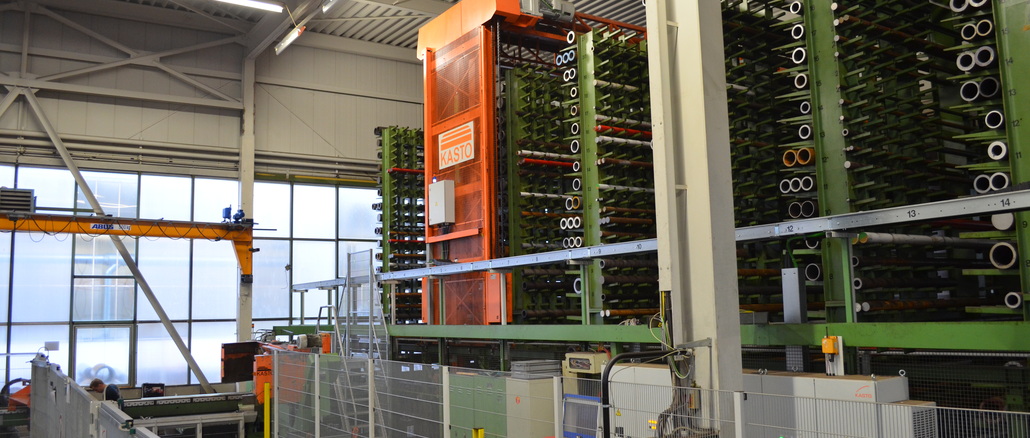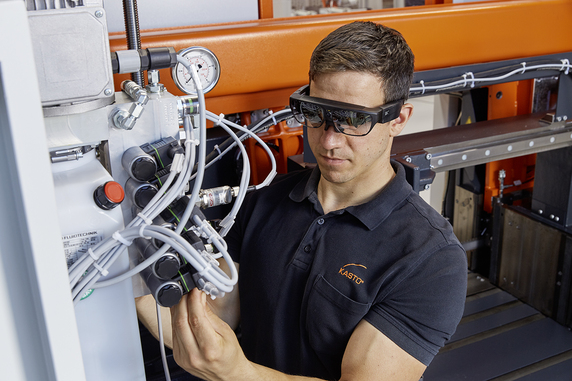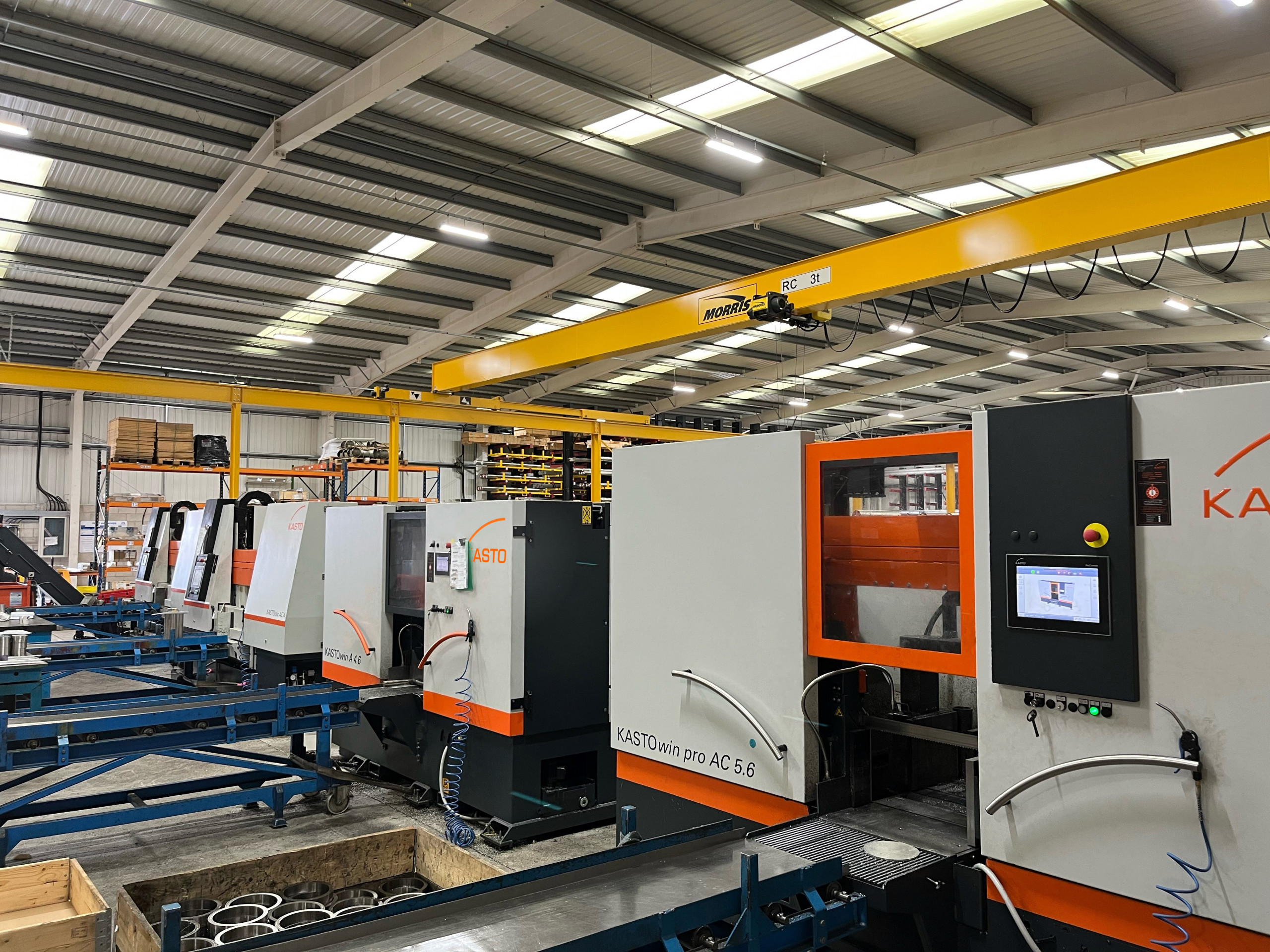
In the case of durable capital goods such as logistics and production equipment for metal processing, a retrofit is often an economical alternative to a new acquisition. Even with comparatively small means, the performance, availability and efficiency of the plants can be raised to the level of a new plant. Kasto offers its customers the necessary technical and planning support right from the start.
As a result of the Corona crisis and the associated cooling of the global economy, many companies are unable to make new investments to the usual extent. Particularly in the case of long-lived machines and systems, the often high acquisition costs represent a considerable hurdle in times of economic uncertainty – even if these are usually amortized in the long term through increases in performance and efficiency. At the same time, companies are faced with the challenge of ensuring their competitiveness and ability to deliver, even in the current difficult environment. Outdated technologies can quickly become a risky and expensive nuisance.
Outdated technology leads to failures
This is particularly evident in storage technology, for example: automatic long goods and sheet metal storage systems are an indispensable part of intralogistics in most steel trading companies and metal processing plants. They provide the required goods quickly, efficiently and ergonomically at the desired time and place, thus ensuring a smooth flow of materials. However, this process comes to a standstill when the technology is no longer up to date: malfunctions and failures accumulate, and the procurement of spare parts and support become increasingly difficult. As a result, the performance of the warehouse suffers – and so does the entire process chain.
Here, a retrofit is an economical alternative to a new acquisition. After all, the storage systems essentially consist of robust steel construction as well as solid Kasto mechanical engineering.
“Most of our long goods and sheet metal storage systems are still mechanically in perfect order after 20 or 30 years in use,” explains Alfred Schwörer, Head of Retrofit at storage and sawing technology specialist Kasto Maschinenbau. The company, headquartered in Achern, Germany, therefore also supports its customers in the professional modernization of existing systems. “Even the replacement of a few small components can make a big difference,” Schwörer explains.
Components brought up to date
This category includes, among other things, the regulation and control technology as well as drives and measuring systems installed in the storage and retrieval machines (SRM). Therefore, Kasto normally replaces all control cabinets in its retrofit projects and exchanges outdated control systems – Siemens S5 are often still in use in older plants – with modern S7 according to the latest state of the art.
More efficient three-phase drives are replacing existing DC motors. Replacing drive controllers, transducers and sensors will improve the performance and energy efficiency of the bearing. New cables and energy supply chains help to make the power supply to the RBG safer and more reliable.
The Kasto expert also considers it sensible to replace operating elements and software: “Older systems often still have control panels with buttons, and there is no screen. We then replace these with touchscreens with a graphical user interface – this is much more intuitive for the user and enables a much greater range of functions.” Among other things, this makes it easier to keep track of order data and inventories – which increases transparency and reduces the risk of errors.
On the software side, Kasto also offers, for example, its own Warehouse Management System (WMS) Kastologic, modern and modular solutions to make the control and management of all processes in and around the warehouse easier and more efficient.
Alternatively or additionally, the automated warehouses can also be connected to the existing ERP systems of the companies via individual interfaces in order to integrate them even better into a continuously controlled material flow.

© Kasto Mechanical Engineering
Focus on safety and occupational health
The topic of security – including the associated technology – is also playing an increasingly important role. Whereas a few years ago, for example, simple light barriers protected employees from injury, complete light curtains now shield the hazardous areas in the warehouse and automatically switch off the system on contact. Here, too, Kasto brings everything up to the latest safety standards as part of its retrofit projects, so that the systems meet all requirements in terms of occupational safety.
Another possibility is the integration of industrial robots: these automated helpers are taking over more and more tasks in metalworking, such as sorting, deburring or stacking. This allows unmanned operation, especially in combined storage-sawing centers, from the storage of the raw material to the finished cut.
“With a retrofit, in most cases we can significantly extend the service life of our systems, as well as those of other manufacturers – while at the same time achieving higher performance, improved availability and increased energy and cost efficiency,” Alfred Schwörer summarizes. “Modernization can also be worthwhile for sawing machines, especially larger models or complex systems, and can bring tremendous benefits – for example, higher cutting performance, longer tool life or an expanded range of applications.”
Regular maintenance is also important to ensure that the systems run smoothly even under heavy load. Of course, Kasto also supports its customers in this respect and offers different approaches to solutions depending on requirements. For example, the long goods and sheet metal storage systems of the Baden-based specialist can largely be maintained remotely.
From Achern, the helpdesk technicians can connect to the system online at any time and thus quickly identify and easily rectify faults or optimise processes. In addition, the Kasto hotline is available around the clock to help users with questions and problems. In the event of an emergency, experts are on site in the shortest possible time and spare parts for all current systems are always available.
Virtual view into the warehouse from a distance
Kasto is taking a completely new approach with its VisualAssistance maintenance concept: at the heart of the system is an interactive app for tablets, smartphones or smart glasses. Customers can use it to connect with service staff via video and audio stream. Users and technicians share the same field of view in real time. This facilitates mutual understanding immensely and helps to quickly identify individual system components and possible faults.
The Kasto experts also have the option via the app to provide visual assistance and, for example, to fade in markers in the live video. While the customer is performing maintenance or repairs on the saw or bearing on site, he receives all the necessary information directly on his display via augmented reality. If he uses the smart glasses, he also has his hands free – which makes the work even easier. The service technicians of Kasto are virtually on site and guide the employees accordingly.
“Time-consuming training courses or expensive journeys become partially superfluous through the use of VisualAssistance”, emphasises Schwörer. “At the same time, users benefit from minimal downtime and high availability and productivity of their equipment.” New technologies like these enable Kasto to support its customers even more flexibly and individually – and that pays off for both sides: “Thanks to the high quality of our products and our comprehensive service, warehouse operators can rely on their systems for many years,” describes Schwörer. “This creates customer satisfaction – and, in turn, makes us the first choice when it comes time to perhaps invest in a new system again.”
Web:
www.kasto.com



